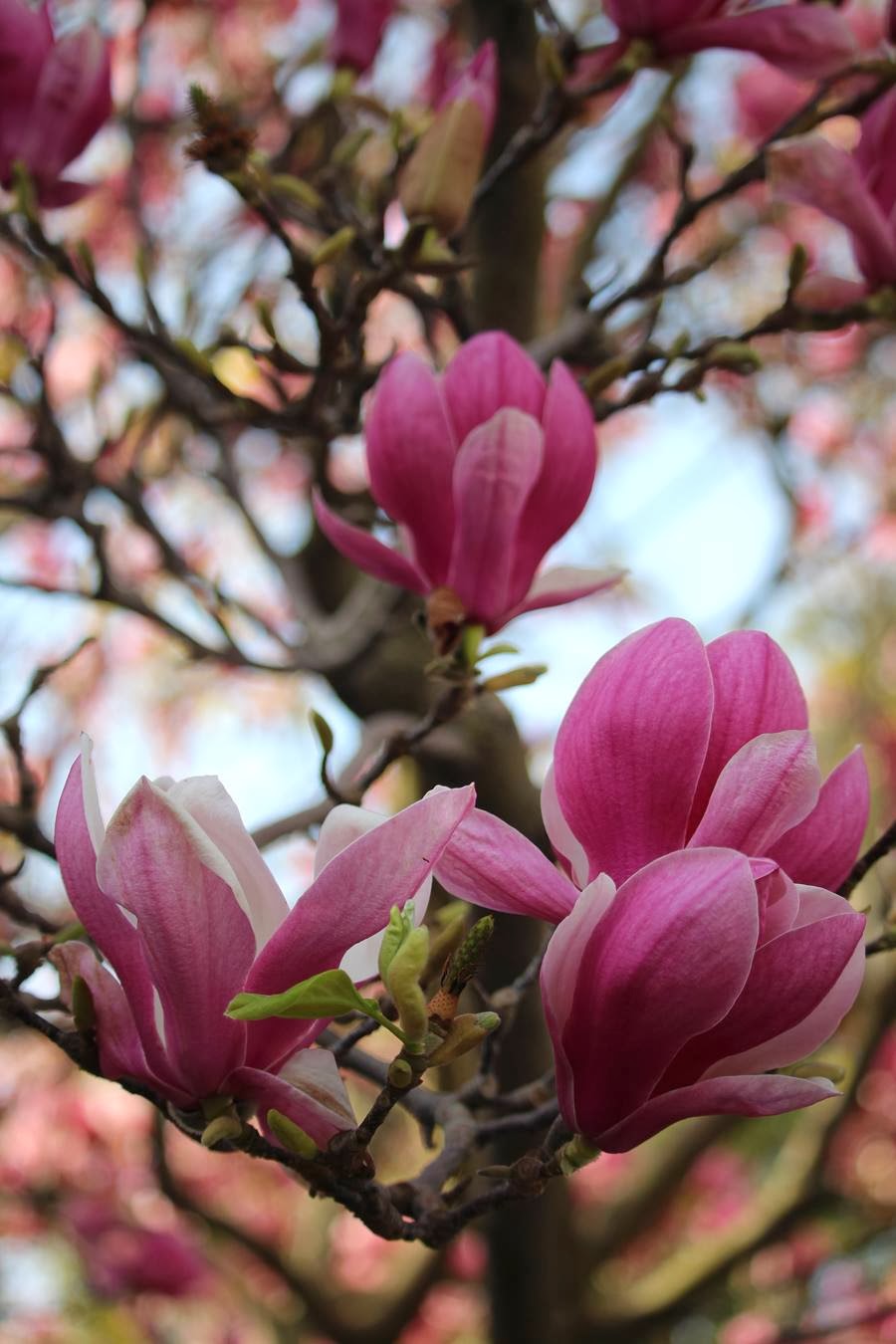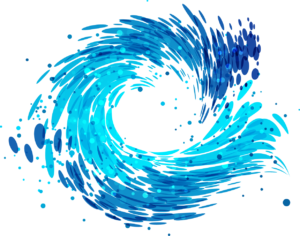by Baxter
 |
| Magnolia Blossoms by Melina Meza |
Over the years I have heard a lot of talk about yoga and the sinuses. For example, one of my first teachers claimed there was an old sadhu practice for addressing congestion in one of side of your sinuses (you have sinus cavities behind your forehead bones, your cheek bones and deep behind your nose itself) where you make a fist and jam it high in the opposite side armpit and clamp your arm down around it for a few minutes. The congested side is supposed to open up promptly. There is even a crutch that is apparently used for such purposes in India. My own experiments on this technique are inconclusive!
A quick check of Timothy’s list of 75 health conditions that yoga helps does have one reference to a study looking at yoga for sinusitis inflammation of the sinus cavities that can be caused by bacteria or virus, as well as allergens, Efficacy of daily hypertonic saline nasal irrigation among patients with sinusitis: a randomized controlled trial. Interestingly enough, the study is not looking at what most of us would think of as modern yoga practice via postures, but a practice of using the neti pot to irrigate the sinuses with warm water, a practice that falls into the category of shat-karma or “six acts” of Hatha Yoga, and is actually a preparatory practice called jala-neti, in which water with a bit of salt dissolved in it is sniffed up the nose.
First let me say that I was pleased to see that the study was published in the Journal of Family Practice, one I have subscribed to over the years—way to go, family docs! But what did this study find? They had the experimental group irrigate their sinuses daily for six months, and here is what they discovered:
“Daily hypertonic saline nasal irrigation improves sinus-related quality of life, decreases symptoms, and decreases medication use in patients with frequent sinusitis. Primary care physicians can feel comfortable recommending this therapy.”
Sweet! A little further digging on PubMed brought up this study done in India in 1991 that looked at posture’s effect on nostril dominance, that is, which nostril is more open at any moment. If you check yourself throughout the day to see which nostril is more open, you will note that it changes every few hours. The author noted that if you started out lying on your back and your left nostril was more open and the right one more congested, by lying on your left side, within in a four to eleven minutes, the right side will become more open and the left side will become more congested. The author postulated that this was “a reflex effect due to the pressure stimuli to the lower lateral side of the body particularly around the shoulder region and effect was mediated through the sympathetic innervation to mucosal venous sinuses of the nostrils.”
This could play out in our yoga asana practice in side lying poses like Vishnu’s Couch (Anantasana) or even side bending poses like Triangle (Trikonasana) or Gate (Parighasana). But you’d have to be in them for at least four minutes to start to see the effect! This lead me to another study done in India with that crutch I mentioned at the beginning of the post, and lo and behold, it took about 17 minutes to get the same effect that lying on your side did. Which would you rather try?
If we get back to the idea of yoga asana and related tools for sinuses and, in particular, sinusitis, which can be an actual infection of the sinuses, there are lots of recommendations online. However, inversions are mentioned in several of these, and my experience is that students with sinus congestion from the common cold or sinus infections often have a significant increase in pressure and headache symptoms as well as worsening of breathing in the forward bend or inversion, often forcing them out of these positions. So for acute sinus symptoms, you may want to hold off on these groups of poses.
According to long-time Iyengar teacher Dean Lerner in an Ask the Expert post for Yoga Journal, inversions again play high on the list of recommended poses, especially Shoulderstand and Plow pose. In addition to the possible worsening effect on acute sinus symptoms, you really need to be a fairly experienced practitioner to do these poses safely. He does postulate that the inverted poses increase the blood flow to the sinuses and this has a flushing effect. However, the blood stays in the blood vessels and does not actually move out into the sinus cavities themselves, so this theory is seriously flawed. And remember, this is just theory, and has not been formally studied.
On the other hand, I found more reasonable recommendations on the Indian Mirror website. The sequence is worth trying because it is unlikely to aggravate sinus pressure and pain while still moving your spine and head into potentially beneficial positions of gentle forward bends, backbends from a prone position, side bends and mild inversions. The sequence features Mountain pose (Tadasana), Seated Forward Bend (Paschimottanasana), Camel pose (Ustrasana), Triangle pose (Trikonasana), Downward-Facing Dog pose (Adho Mukha Svanasana), and Cobra pose (Bhujangasana), and, in an additional section, Knees to Chest pose (Pavanmuktasana, which I usually call Apanasana), Raised Stretched-Out Foot pose (Urdhva Prasarita Padasana), Lion pose (Simhasana), Bow pose (Dhanurasana) and Savasana. And, for breath work, the Bellows Breath known as a Bastrika. If I were to modify this sequence, I’d recommend the following:
- Bending the knees in Paschimottanasana to make it easy on the back
- Skip Camel due to its more advanced requirements
- Monitor Downward-Facing Dog to make sure it does not worsen my symptoms
- Repeat Cobra if Bow pose feels to much for the back
- Elevate the spine and head for easier breathing in the supine position, Savasana
More importantly, I’d remind us all that yoga has been studied and found to have a positive effect on the immune system, and, ultimately, if the immune system is functioning at its peak, we are going to have the best chance of influencing the course and re-occurrences of sinus problems. That means establishing a regular home practice that is well balanced, and includes pranayama practices such as alternate nostril breath, nadi shodhana, as well as seated meditation in addition to our beloved asanas. From there, if the concept intrigues you, I’d recommend experimenting with gentle inversions like Downward-Facing Dog and Standing Forward Bend. Or try out the poses recommended by the Indian Mirror above if that grouping seems appealing to you. And rest and do restorative practices when you are acutely sick and save the more physical practices for your recovery time. Since we don’t have any formal studies on these tools of yoga and sinuses yet, you are effectively investigating the practices to find what works best for you. Let us know what you discover!
Follow Yoga for Healthy Aging on Facebook ° To order Yoga for Healthy Aging: A Guide to Lifelong Well-Being, go to Amazon, Shambhala, Indie Bound or your local bookstore.


I had a cold about a month ago–sore throat, swollen sinuses, mucous. I performed the colds sequence in BKS Iyengar's Yoga The Path to Holistic Health. When I looked at the sequence I groaned and almost didn't begin because it is heavy on inversions and I already had this sense of swollenness and pressure in my head. I thought turning myself upside down would only increase the feeling. But in the interest of science, and the interest of feeling better, I began. Miraculously, with the first pose (Uttanasana with head and hand support) my sinuses began to cool out and it felt like they shrank back toward normal. Each pose in the sequence continued that feeling of cooling and soothing. It was so beneficial that I did the sequence every day for three days by which time the symptoms had subsided.
I had a cold about a month ago. I did the colds sequence in BKS Iyengar's The Path to Holistic Health. When I first reviewed the sequence I almost didn't begin because the sequence was heavy with inversions, which was the last thing I wanted to do with swollen sinuses, a sore throat, and mucous. I worried that turning upside down would only increase the sinus pressure I was feeling. In the interest of science, and in the interest of feeling better I began the sequence with Uttanasana with head and hand support. Miraculously with this first asana my sinuses began to cool and feel much less inflamed. As I continued the sequence the swollenness in my sinuses disappeared. I liked the sequence so much that I did the sequence once a day for three days until the symptoms totally abated. I have no idea why it worked but it did.
I get sinus infections pretty regularly and this year Eustation tube dysfunction has been really bad, both due to allergies. I did an inversion (spotted forearm stand) while feeling fullness in my ears and other mild sinus symptoms. After inversion I felt remarkably better. Almost completely back to normal. I had no clue that inversion could ever be helpful, so happy to find yet another aspect of life my yoga practice is improving.